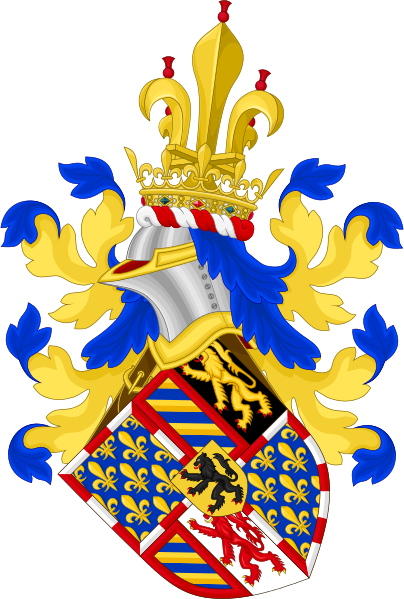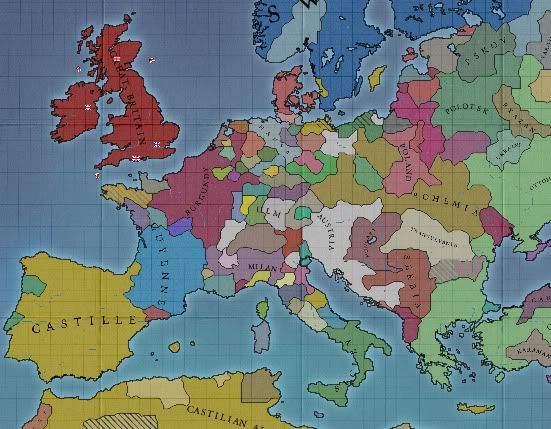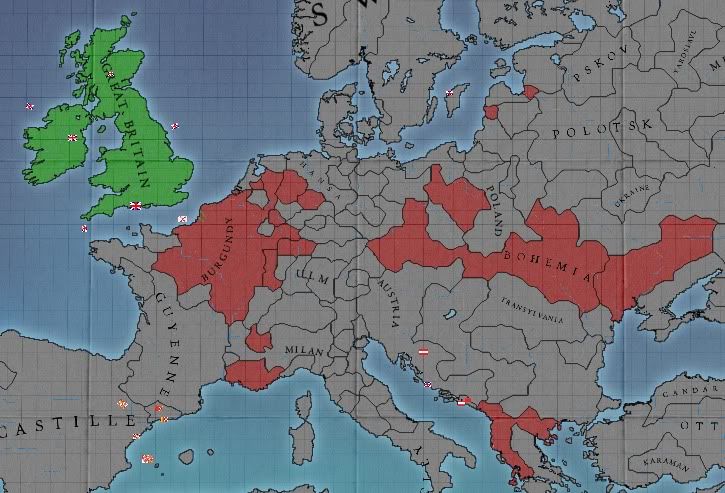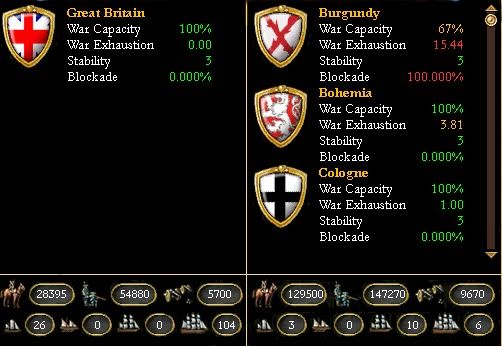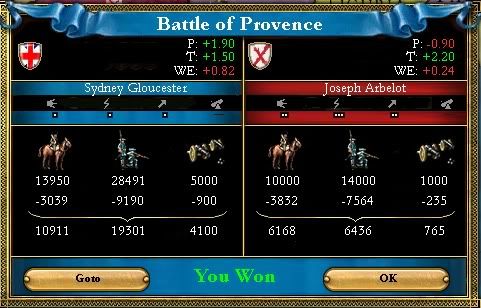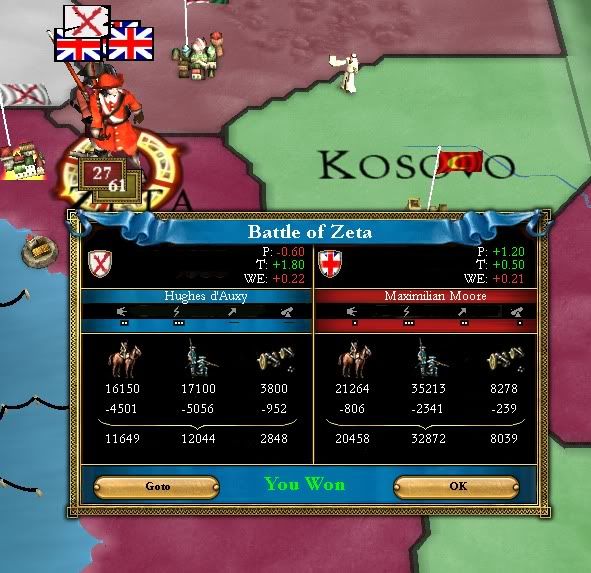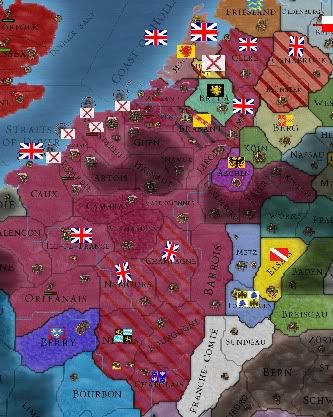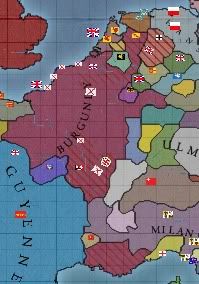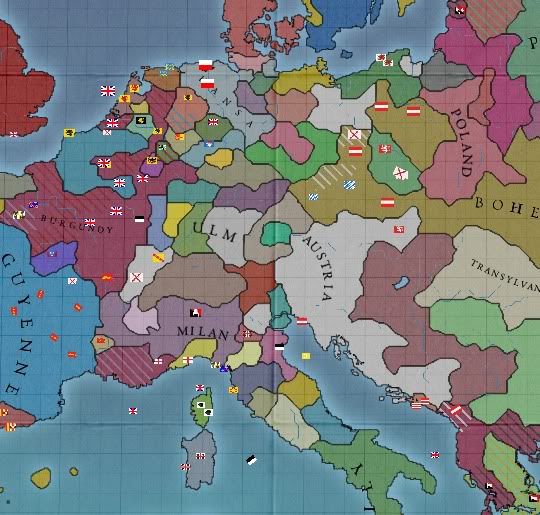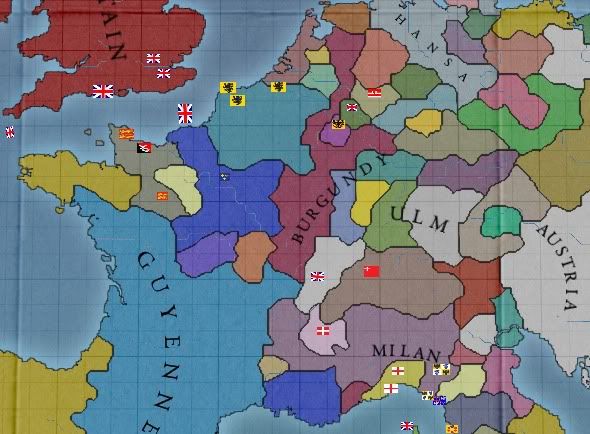Act 2: The War of 1573-1580
Political map of Europe in 1573.
Burgundy and her allies.
During the opening days of February 1573 the Royal Navy slipped away from ports in England, the Americas, Africa, Austria, and various ones belonging to Castile. They moved into position to emplace a total blockade of Burgundy from the first day of the war, which was eventually declared on the 16th.
The strength of the two alliances.
On 4 March the first blow was struck against Burgundy. Marines, the American garrison, landed and seized the island of Dominica. By the end of April Burgundy’s African colonies had been occupied by the Royal Army returning from India, and on 3 May her South American colony was seized. In just two and half months Burgundy’s colonial empire had been overrun. The Royal Army was returned home, after six years abroad fighting.
With the fleet of transport ships back in home waters, and repaired, they were next dispatched with the Army of Scotland to the Baltic. The troops were to capture Memel and Riga, the two Baltic possessions of Burgundy. It was envisioned that the objective would be completed by the end of the year due to the lack of any troops. The first landing was made in Riga but the Army of Scotland was not able to capture the city as rapidly as it was first believed. The siege dragged on through to 1574. By then, further troops had been dispatched to the Baltic. They were landed in Memel and quickly captured the city. They proceeded to advance overland– violating other countries’ sovereign territory in doing so – and assisted the Scottish army in their siege that came to an end after 208 days. The remnants of these two armies were then ferried home. In June the Burgundy fleet was lured out into the English Channel and destroyed in a single battle. During the course of the year the transport fleet was expanded and in December landed 40,000 men in Milan, an ally of our nation but who had not been called upon to fight.
1575-76 campaign
After a rest to replenish troop numbers, quite a few men succumbing to various diseases during the passage from England to Milan, the 40,000 men-two armies–marched for Savoy. In early March they destroyed the 5,000 strong army of that kingdom but were unable to capture the city. Against all odds the defenders of the city, held out until May. The two armies then turned south to tackle the two Burgundy territories along the Mediterranean coast. Over the next few months the two British armies laid siege to the southern Burgundy cities. In September, the soldiers, now reinforced heavily with mercenaries, engaged and destroyed a Burgundy army in the course of two battles. This marked a major milestone, it was the first time in countless wars that a sizeable Burgundy army has been engaged and actually defeated; in practically every major engagement in previous wars the British armies had been mauled. Several additional defeats were then inflicted upon Burgundy inflicting heavy losses, however by the end of the year over 25,000 enemy soldiers were heading towards this area, violating Austrian soil in doing so.
Two battles that would go down in British history: the first time the Burgundy metropolitan army had been taken on and defeated.
In March, the reinforced Burgundy armies were able to liberate Savoy but were checked by British forces from advancing any further. In the coming months further mercenaries were hired and two more British armies were deployed to Milan; leaving only 20,000 men–one army–defending the British Isles. Several more Burgundy armies were routed and on 4 July Savoy was once again taken. Later that day Savoy accepted a peace deal in which they renounce their treaties with Burgundy; as a reward to Milan, Savoy was made to revoke all claims on various territories held by Milan; and as defender of the faith Britain imposed the Protestant faith upon the defeated people of Savoy. On 5 October, the Mediterranean cities finally fell. The campaign was over, and a sizable mercenary force was hired to protect the territory gained and to defeat the roaming Burgundy soldiers who were active, south of the Alps, in small numbers.
1577 Campaign
As the previous campaign was drawing to a close, two of the armies were withdrawn and transported to the Balkan coast; part of Austria, who has been granting military access to Britain for decades. The next campaign was to be launched to capture the Burgundy Balkan territories. In early 1577 the remaining two British armies were withdraw from southern Gaul and transported to the Balkans. These two however were landed in Ottoman Greece, relations having been built up between both countries as the Ottoman Empire, before their dramatic defeat, was a possible candidate for an alliance to further our policy of defeating Burgundy. In their place, in Gaul, the largest mercenary army ever assembled by Britain had been created: close to 60,000 men.
In March, the British troops in Austria advanced south. Burgundy countered this move by concentrating her forces and launching an attack north. As they did this, the British troops in Greece marched northwards to attack the Burgundy garrison from behind. In April their army was routed. However it would take all summer to finally destroy the garrison. Following which the various territories were taken one at a time, with the campaign ending on 4 September 1577 with the capture of the final Burgundy province.
The main battle of the 1577 campaign
The British troops were returned home, and a small mercenary force was raised, again, to protect the gains made. Over the next 17 months, peace essentially broke out as the soldiers were given a break from fighting to appease the growing war wariness among the population.
1579-80 Campaign
In early 1579 it was brought to the attention of Frederick just how weakened Burgundy had become. It became apparent they had wasted much of their strength in 1576 attempting to halt our sieges. Their paper strength, of hundreds of thousands of men, now must have lain with the Bohemian army and thus be out of reach of the Burgundy homeland. The unending blockade had resulted in a very high level of war exhaustion among Burgundy, and it then came to light that there were no soldiers based in neither the Netherlands or Flanders – home usually to tens of thousands of their men.
Four of our five armies were deployed to the Netherlands. They quickly swatted aside the minimal resistance offered. As more Burgundy troops began to assemble to oppose our invasion, the mercenaries were ordered to advance north. On 2 May, the mercenaries sacked the Burgundy capital and kept up the advance. The regulars and the mercenaries were now edging closer and closer towards linking up. Burgundy was able to rally enough forces to halt the mercenary advance during late June. In July, the Army of Ireland, the only reserve available, was committed to the campaign but it was not enough to revitalise the northern front which had now bogged down. On 18 August, Milan was called upon to attack Burgundy. With their support, it was imagined that the British and mercenary forces would be given the time needed to rejuvenate and resume the offensive. Thus, the mercenary advance north was resumed, with a good portion of the men heading north west to take Paris. However on 29 November, Milan and Burgundy arranged a white peace and once more the fighting bogged down.
The height of the British advance.
The situation prior to the peace treaty.
Over the next four months various victories were scored, but Britain now lacked the military strength to push home the advantage gained. On 20 March 1580, a deal was struck with Guyenne who then joined the war. However 11 days later they also struck a deal, like Milan, with Burgundy to halt their offensive for a white peace. The war would drag on for a further two months. In April, the mercenary advance was again halted and this time driven back. Additional Burgundy forces were assembled for a determined drive south, resulting in the mercenaries concentrating to parry it. They were just able to halt the Burgundy march on their capital, but one more battle and the mercenary force would be no more. In the north, the five armies were able to hold on to what they had gained but were unable to attack further. The high water point had been reached. If the war dragged on any further the mercenaries would be routed, and the regulars could possibly also be defeated, and the ability to dictate terms lost. Therefore, after seven years of fighting and coming to what appeared to be antagonizing close to total victory, a treaty was drawn up and Burgundy signed. Burgundy released Flanders as an independent kingdom and handed over their African colonies to Britain. The knockout blow may not have been landed, but Burgundy had been serious weakened and Henry VI’s ambition had finally been realised.

